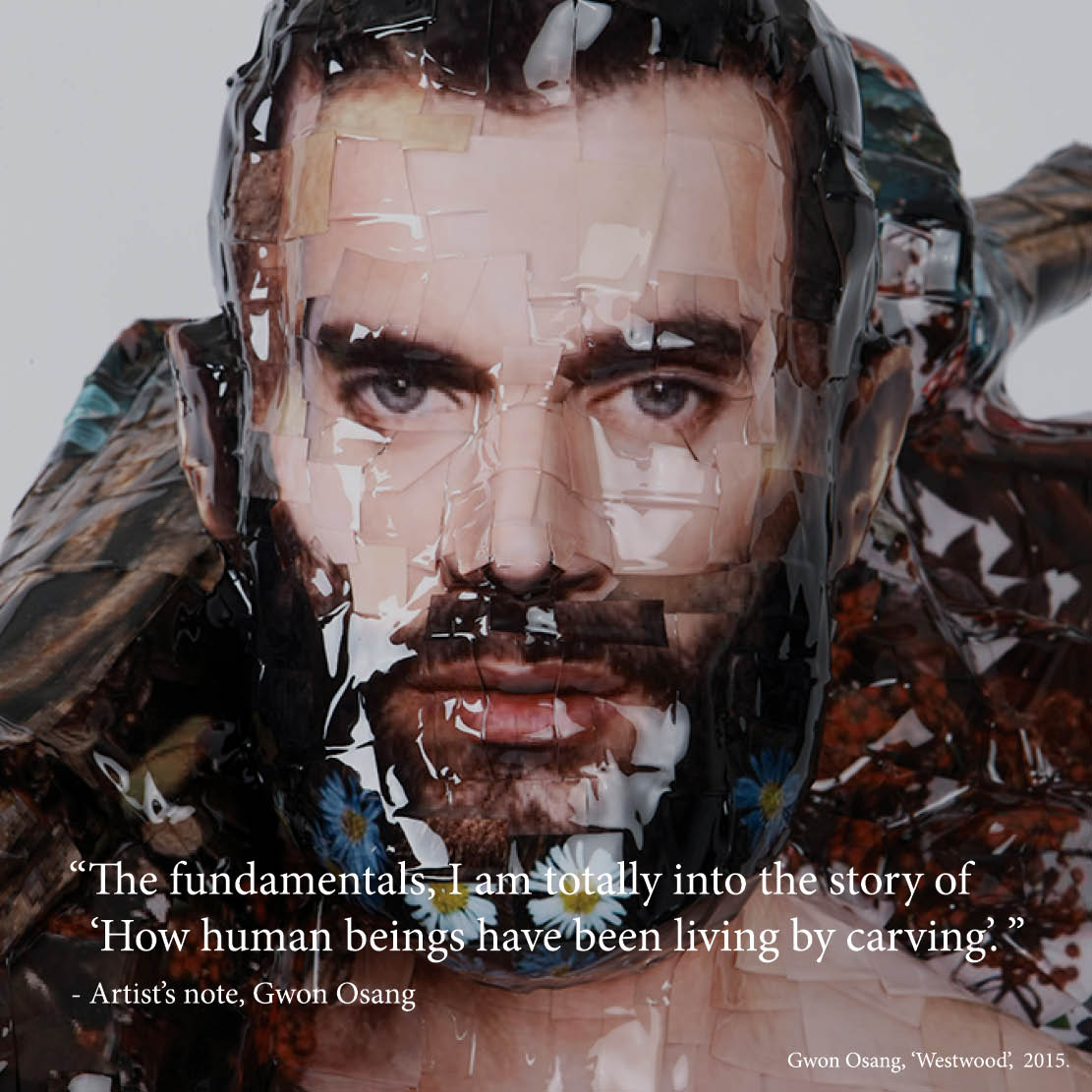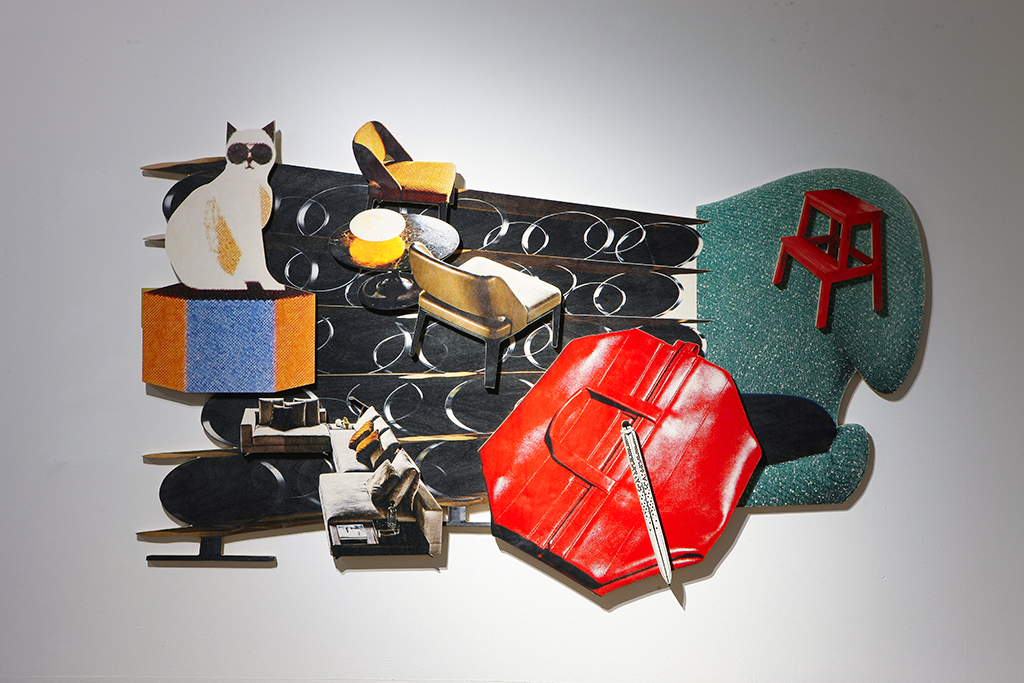Gwon Osang (b. 1974), known for his so-called "photo-sculptures," has continuously questioned the identity of sculpture while exploring new structural forms. Through the medium of photography, he has carried out various experimental and innovative sculptural attempts that challenge the traditional modes of existence of sculpture.
 Gwon Osang, Family
Photo of 440 Pieces Composed of Tenacity, 1998-1999 ©Gwon Osang
Gwon Osang, Family
Photo of 440 Pieces Composed of Tenacity, 1998-1999 ©Gwon OsangGwon Osang conceived lightweight sculptures
using two-dimensional photographic images printed on paper, rather than relying
on traditional, heavy materials like marble. His exploration of sculptural
forms through the medium of photography began to take shape with the Deodorant
Type series, which he started in the early 1998s.
The term “Deodorant Type” is a compound
word coined by Gwon himself. It combines "deodorant," a product that
conveniently replaces an existing smell with another, and "type," a
term commonly used in photographic processes such as ambrotype and
daguerreotype.
 Gwon Osang, A
Statement of 540 Pieces on Twins, 1999 ©Gwon Osang
Gwon Osang, A
Statement of 540 Pieces on Twins, 1999 ©Gwon OsangBy attaching the word "type," as
though it were a term already existing in the history of photographic
techniques, the artist presented his ontological exploration of sculpture
through its fusion with the medium of photography. Inspired by the slightly
off-kilter phenomenon of deodorants—items largely unnecessary for East
Asians—being heavily advertised, this series reveals a divergence and
misalignment from its subject during the process of creating three-dimensional
forms, despite being photographic in essence.
To achieve this, the artist produced
three-dimensional photo-sculptures by cutting and pasting hundreds of
photographic images taken from various angles of the subject. Additionally, he
utilized features inherent to photography, such as enlargement, reduction, and
duplication. For instance, A Statement of 540 Pieces on Twins
(1999) consists of two sculptural figures created from a single photographic
source, showcasing an ambiguous existence where reality and illusion
intertwine.

Gwon Osang, Hockney, 2013 ©Gwon Osang
While Gwon's early works were primarily created using photographic images he captured himself, his later pieces were made using images sourced from magazines, advertisements, and the internet. Additionally, whereas the early Deodorant Type works were hollow in structure, later iterations evolved to use forms made from rigid Styrofoam (Iso Pink), which were then entirely covered with photographic images.

Gwon Osang, Westwood, 2015 ©Gwon Osang
The sculptural exploration initiated with
the Deodorant Type series reflects a contemplation of
sculpture in a modern context through the lens of contemporary imagery. For
instance, in the later work Westwood (2015), Gwon
reintroduced the pedestal—a characteristic of traditional sculpture—while
applying a contemporary sculptural language interpreted by the artist.
Thus, while the mechanisms of the
photographic medium are a significant element in his photo-sculptures, Gwon's
works fundamentally engage with questions about the methodologies and ontology
of traditional sculpture, examining the very nature of "sculpture"
itself.

Gwon Osang, The Flat 2, 2004 ©Gwon Osang
In
2003, Gwon introduced The Flat series, which presented flat
sculptures created by collecting contemporary images commonly found in
magazines. This series consists of images the artist had meticulously gathered
since 1999, primarily featuring luxurious objects such as watches and jewelry.
The
process involved cutting out the magazine images along their outlines and
attaching wires to the back of the cutouts to make them stand upright on the
ground. After constructing these flat images into a three-dimensional form,
Gwon ultimately reconverted them into a photographic work, returning to the
flat medium.

Gwon Osang, The Flat 15, 2005 ©Gwon Osang
Through The Flat, Gwon repeatedly explored this reversal process, raising questions about one of sculpture's central themes: the relationship between flatness and three-dimensionality. Moreover, the intricate interplay between the flat and the three-dimensional in The Flat reveals a clear connection to his earlier Deodorant Type series, furthering his investigation of sculptural concepts through the medium of photography.
 Gwon Osang, The
Sculpture 2-Car, 2005 ©Gwon Osang
Gwon Osang, The
Sculpture 2-Car, 2005 ©Gwon OsangIn contrast to his earlier series, Gwon’s The Sculpture series, introduced in 2005, does not emphasize photography as a primary sculptural material. Instead, the artist gathered information about his subjects—luxury supercars such as Lamborghinis—from sources like the internet, books, magazines, and miniature car models without directly observing the actual objects. Based on this research, he created sculptures using traditional bronze, which he then painted with acrylic to resemble lightweight plastic objects.

Gwon Osang, The Sculpture 2-Car(detail), 2005 ©Gwon Osang
Although the The
Sculpture series differs in physical characteristics from his earlier
photo-sculpture series, it remains connected through its reinterpretation and
contemporary adaptation of traditional sculpture. This series reimagines the
historical intent of traditional sculpture, which sought to closely approximate
an idealized reality, within a modern context.
By using supercars—symbols of today’s
capitalist utopia—as his subject and combining the classical material of bronze
with playful interventions like orange acrylic paint, Gwon prompts reflections
on the meaning of traditional sculpture in the contemporary era.
 Gwon Osang, New
Structure, 2016, Installation view of “Gwon Osang: New Structure and
Relief” (Arario Gallery, 2016) ©Arario Gallery
Gwon Osang, New
Structure, 2016, Installation view of “Gwon Osang: New Structure and
Relief” (Arario Gallery, 2016) ©Arario GalleryIn
his 2016 solo exhibition “Gwon Osang: New Structure and Relief” at Arario
Gallery, Gwon introduced the New Structure and Relief
series, which continue to build upon his earlier works. In the New
Structure series, Gwon expanded the concept of flat sculptures seen
in The Flat series, transforming them into larger-scale,
more solid installations, thus broadening the discussion of sculpture into
spatial dimensions.
For
New Structure, Gwon enlarged collected images of objects and
crafted them as flat forms, which were then structured into standing
installations. Rather than adhering to a specific narrative or purpose, Gwon
allowed his process to be autonomous and unconscious, focusing primarily on
aesthetic judgment in shaping the forms. The space created by New
Structure, though devoid of a specific narrative, possesses the
unique spatiality and theatricality of sculpture, enabling it to generate and
convey events through its presence alone.
 Gwon Osang, Relief
16, 2016 ©Gwon Osang
Gwon Osang, Relief
16, 2016 ©Gwon OsangIn
the New Structure series, Gwon Osang explored the
relationship between sculpture and space, while in the Relief
series, he actively employed modeling techniques to sculpturally arrange
contemporary images, reflecting his engagement with current cultural contexts.
For
the Relief series, Gwon selected images from ‘Wallpaper,’ a
design magazine known for capturing global cultural trends with speed and
precision. He arranged and combined these selected images on flat wooden
panels, layering them to transform the two-dimensional surface into a
three-dimensional sculptural form through a modeling process.
As
with his other works, there is no specific narrative or concrete meaning
embedded within the collected images. The creation process involves repetitive
acts of adding and subtracting image clusters in an improvised and unconscious
manner.
 Gwon Osang, Reclining
Figure 4, 2022 ©Gwon Osang
Gwon Osang, Reclining
Figure 4, 2022 ©Gwon OsangGwon Osang's recent works delve into the
abstraction of sculpture, inspired by the fragmented and perforated forms
characteristic of 20th-century British sculptor Henry Moore. By studying
Moore's treatment of the human figure, where bodies are deconstructed into
abstract shapes or include voids, Gwon integrates these concepts into his
photo-sculpture practice, evolving his distinct visual language.
The Reclining Figure
series (2020–), an homage to Henry Moore, features abstract and organically
composed human figure sculptures that merge photography and sculpture. The
photographic images placed on the abstract sculptural forms provide a sense of
visual dynamism to the static shapes by featuring various temporal and spatial
backgrounds or overlapping perspectives.
 Gwon Osang, Reclining
Figure 5, 2022 ©Gwon Osang
Gwon Osang, Reclining
Figure 5, 2022 ©Gwon OsangIn
contrast to his earlier photo-sculptures, which were created by attaching
photographic paper, the Reclining Figure series marks a
shift as Gwon began printing images on matte fabric, introducing a change in
the sculptural form and texture. By inflating the structures with air and
fixing their forms, these works evolved into massive sculptural installations
that occupy substantial portions of exhibition spaces.
Gwon's
ongoing investigation into the identity of sculpture serves as the central
thread connecting his various series. Each body of work influences and informs
the next, creating an organic, interconnected evolution of ideas. Rooted in his
focus on contemporary life, Gwon's practice consistently reflects contemporality
while engaging in innovative experiments with form and medium. His ability to
merge different media seamlessly not only pushes the boundaries of art but also
offers a fresh perspective on what sculpture can represent in today's context.
“The fundamentals, I am
totally into the story of ‘How human beings have been living by carving’.”
(Gwon Osang, Artist’s Note)

Artist Gwon Osang ©Leeum Museum of Art
Gwon
Osang graduated from the Department of Sculpture of Hongik University College
of Fine Arts and obtained his master's degree from the graduate school of the
same university. He has held solo and collaborative exhibitions at Lotte
Avenuel Art Hall (Seoul, 2023), Ilmin Museum of Art (Seoul, 2022), Suwon Museum
of Art (Suwon, Korea, 2022), Arario Gallery (Seoul, Korea; Shanghai, China,
2016), among others.
His
solo exhibitions have been showcased worldwide at venues such as Hermès
(Sydney, Australia, 2016), Waterfall Gallery (New York, US, 2016), Okinawa
Contemporary Art Center (Okinawa, Japan, 2015), Joyce Paris (Paris, France,
2014), HADA Contemporary (London, UK, 2013), Manchester Art Gallery
(Manchester, UK, 2008).
Group
exhibitions showcasing his works have been held at Arario Gallery (Seoul, 2024;
2023; 2018; 2014; 2011; 2010), Gyeongnam Art Museum (Changwon, Korea, 2023),
V&A Museum (London, UK, 2023), The Shop House (Hong Kong, 2022), Daelim
Museum (Seoul, 2020), National Museum of Modern and Contemporary Art (Seoul,
2015), Singapore Art Museum (Singapore, 2014), and Saatchi Gallery (London, UK,
2010). His works are part of the collections at institutions including the
National Museum of Modern and Contemporary Art, Seoul Museum of Art, Busan
Museum of Art, and Leeum Museum of Art in Korea.





















